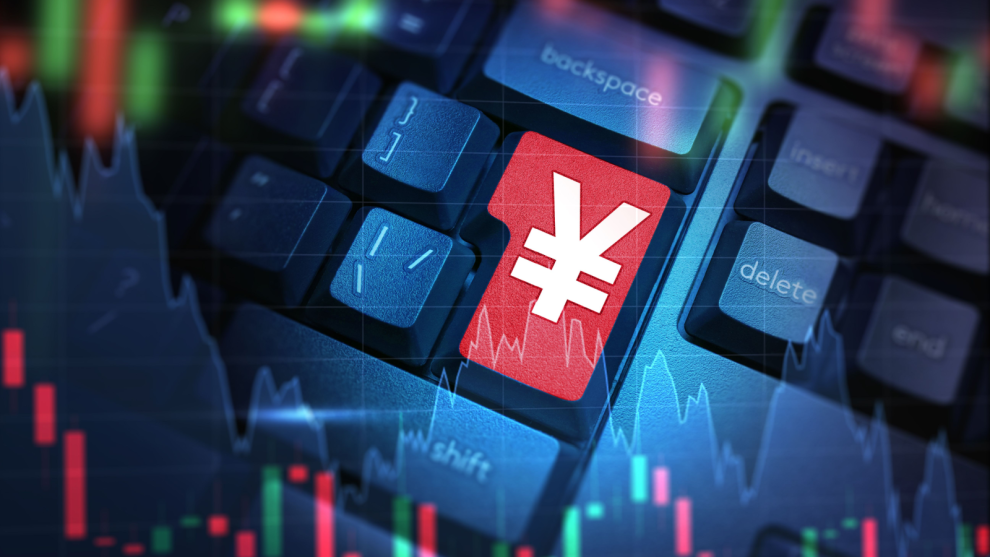
The yen carry trade is back in the news … what it is, why it developed, and why it’s unraveling … the stocks most affected … its impact on the “Great Tech Reversal”
Why are stock prices falling when the Fed is set to lower interest rates to avert a recession and to stop the unemployment rate from rising by boosting economic growth?
We had a glimpse of the answer in early August: The [yen] carry trade is still unwinding.
That came from Louis Navellier’s favorite economist, Ed Yardeni, over the weekend.
Meanwhile, here’s Steve Barrow, head of G-10 strategy at Standard Bank, from late last week:
Carry trade unwinding does represent a serious threat to any rosy view of risk assets going forward…
For all the good a modest and steady Fed rate cut profile might be for riskier assets, the [Bank of Japan] may blow all of this out of the water should its rate hikes create enormous carry-trade unwinding.
Let’s step back…
Between August 1 and August 5, the S&P 500 fell 6% while the Nasdaq dropped 8%. While sudden, outsized pullbacks like that rarely have a single reason, the unwinding of the yen carry trade was a major contributor.
Over the last few days, this trade (and its unwinding) has been back in the headlines. Let’s look at it today to better understand what happened in August, and why the risk of further related fallout is still on the table.
Our goal is to correctly assess the market risk so that we avoid incorrectly labeling potential upcoming volatility as the beginning of a bear market and exit our positions, only to watch a temporary issue (like the carry trade) work itself out as the market roars back to life without us.
How the yen carry trade works and why it blew up in August
One of the most popular trades in recent decades has been the yen carry trade. The profitability of this trade reduces to one main thing – arbitrage.
Investors borrow money in yen, where the cost of borrowing has been virtually zero for decades, then they invest in higher-returning assets elsewhere around the globe – principally, the U.S. stock market.
The take their hefty returns, pay back their cheap loan in yen, then pocket the difference.
To help illustrate, below we look at the Bank of Japan’s key short-term interest rate dating back to the 1970s. Note how it has been, effectively, zero since the year 2000.

Now, it wasn’t just Japanese investors who’ve hopped on the yen carry trade.
Given our global economy, investors from all around the globe were more than happy to borrow in dirt cheap yen, then invest in rip-roaring U.S. stocks.
But assessing just how big the yen carry trade was (and still is) is difficult. Analysts’ estimates have been all over the place, ranging from $1 trillion to $4 trillion.
Whatever the number, the takeaway is the same – this has been a very popular trade, with an enormous sum of capital involved.
How the carry trade became so lucrative
Older investors will remember the Japanese market bubble in the late-1980s that peaked in 1989. This was one for ages.
The Nikkei 225 stock index more than tripled between 1985 and 1989. At its peak, it had a price-to-earnings ratio of 60. The price-to-earnings ratios of specific Japanese stocks were even more absurd: Panasonic’s was at about 300… Nippon Telephone was between 300 and 400… and Sumitomo Realty was over 500.
Meanwhile, the land surrounding the Imperial Palace (about 1.3 square miles) carried a higher price tag than the value of all real estate in the entire state of California.
When this bubble burst, Japan fell into the horrendous deflation of the “Lost Decade” in the 1990s (which extended into multiple decades). The Bank of Japan’s response was 0% interest rates to stimulate growth. However, these 0% rates were no match for the collective effect of the asset price collapse hangover, debt, an aging population, and various banking crises.
So, inflation was basically nonexistent. This was fertile ground for a very profitable and sustained yen carry trade. And as noted earlier, global investors loaded up.
Let’s now fast-forward to the last few years.
Japanese inflation finally registers a heartbeat, the BOJ’s response, and the risk to the yen carry trade
After virtually zero inflation for decades, things began changing in the wake of the pandemic. Snarled supply chains pushed up costs for all sorts of goods. Then, following Russia’s invasion into Ukraine, energy prices leapt higher (Japan is a huge importer of energy). The yen also weakened substantially against the dollar, which made energy and food more expensive.
To combat all this, the Bank of Japan (BOJ) finally acted last spring/summer.
Here’s Reuters from July 11th:
The Japanese yen surged nearly 3% on Thursday in its biggest daily rise since late 2022, a move that local media attributed to a round of official buying to prop up a currency that has languished at 38-year lows…
The scale and speed of the move put traders on alert to the possibility of Japanese intervention. Authorities stepped in as recently as early May to bolster the yen.
A few weeks later, on July 31st, the BOJ officially raised interest rates. Here’s CNBC:
Japan’s central bank has raised its benchmark interest rate to “around 0.25%” from its previous range of 0% to 0.1% and outlined its plan to taper its bond buying program.
This would mark the Bank of Japan’s highest interest rates since 2008.
So, what’s been the effect on the yen?
Remember, a consistent, cheaply valued yen has been the cornerstone of the yen carry trade for decades…
Well, here’s the yen priced in dollars over the last year. The vertical spike I’ve circled is the effect of the BOJ’s actions.
We might title this chart “the cost of the yen carry trade exploding.”

The aftermath of the rapid appreciation of the yen
As we just saw, in July, the yen began skyrocketing. And at the end of July, the BOJ raised rates for the first time in years, which strengthens the yen.
Suddenly, more recent investors in the yen carry trade were looking at a higher price tag to be in it. Since this trade is often put on with massive leverage, the compounded effect of the soaring yen hurt the returns of many investors. So, they sold.
But what, exactly, did they sell?
Well, beyond Japanese stocks, they sold a great deal of U.S. stocks with a concentration in tech…which brings us full circle to the Nasdaq’s 8% haircut between August 1 and August 5 – conspicuously directly following the BOJ’s rate hike on July 30.
But hasn’t the carry trade officially unwound now?
That’s the million-dollar question.
If it hasn’t, we want to know. Because if/when more unwinding comes, we want to see that for what it is, and ride through it confidently. We don’t want to misattribute market weakness to Wall Street deciding we’re in for a recession, causing us to perhaps make emotion-based market decisions that derail our long-term goals.
With all this in mind, let’s return to Ed Yardeni:
The carry trade is still unwinding.
Expectations that the Fed will lower our interest rates, while the Bank of Japan raises their interest rates are boosting the yen and forcing traders to unwind their carry trades, which were executed when they borrowed yen at near-zero interest rates to buy assets with higher returns in other currencies, especially the Magnificent 7 and semiconductor stocks in the US.
There has been a strong inverse correlation between the yen and the Nasdaq 100 since the start of 2023.

So, how much of the trade might be left to unwind?
A few weeks ago, JPMorgan’s cohead of global FX strategy Arindam Sandilya said it might only be halfway over:
We think that the carry-trade unwind, at least within the speculative-investing community, is maybe somewhere between 50% to 60% complete. So, we are not done, by any stretch.
At the heart of the issue are two factors: the price at which traders got their yen to fund the trade, and how high the yen goes during their trade.
While we can’t answer the first question, as you can see below, the yen is at its second highest level relative to the dollar since August of 2023, and momentum is clearly “up.” This likely represents many traders with their feet being held to the fire.

Meanwhile, the BOJ has indicated that it will push rates higher, but not while markets are unstable.
From Bloomberg on Sunday:
Following last month’s market turmoil, Bank of Japan Deputy Governor Shinichi Uchida said the central bank won’t hike rates when markets are unstable. Since then, Governor Kazuo Ueda has backed up his deputy’s stance, while also making the point that the BOJ will continue to raise rates if data show the economy and prices in Japan are following the central bank’s outlook.
Put it altogether, and the odds of another bout of yen-related market volatility have risen.
But as noted earlier, we feature this story in today’s Digest for perspective, not preemptive defensive posturing
The goal here isn’t to get you out of your positions. It’s to let you know ahead of time why there could be more market weakness. Having this awareness can help investors stay invested instead of misinterpreting it as a “hard landing” to avoid.
Of course, we continue to recommend adhering to your stop-losses while maintaining wise position sizes and a balanced portfolio. But having a better awareness of the potential sources of market volatility can help us protect ourselves against fear and snap decisions.
Meanwhile, this entire discussion plays into Luke Lango’s “Great Tech Reversal of 2024” that he’ll discuss more tomorrow night at 8 PM EST
As we saw above in Ed Yardeni’s chart, the Nasdaq 100 has been hit hard by the surging yen. Specifically, Big Tech/AI have taken it on the chin.
While this is a reason to be cautious about tech today, Luke believes investors should still target top AI tech plays, but with a twist…
Here’s Luke to explain:
The era of Mag 7 dominance in the “Age of AI” is ending. A new era – where smaller AI stocks take the lead and shine bright – is upon us.
In this new era, we could see a lot more individual stock opportunities than we did in the era when it was just seven stocks going up. It could be a lot more exciting.
And this new era could potentially get accelerated by a major market event in less than two weeks.
Which is why… to get prepared for this big market broadening… I’m hosting an important strategy session tomorrow Wednesday, Sept. 11, and 8 p.m. EST. Click here to automatically reserve your seat.
During the evening, Luke will unveil what he believes is one of the best investment strategies to capitalize on this potential major market broadening.
I’ll note that if the carry trade continues to roil the markets, goosing some assets while weighing on others, this strategy will help traders find and ride the winners.
Have a good evening,
Jeff Remsburg





